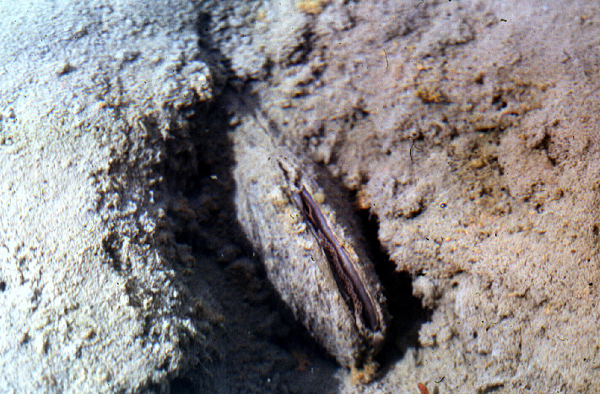The duck mussel, Anodonta anatine, is one of four freshwater mussel species found in Norway. Photo: Bjørn Mejdell Larsen (NINA).
Mussels are the natural treatment plants of bodies of water and, therefore, just as important as bees. Unfortunately, they are equally threatened: most of the world’s mussel stocks are in decline and some species face extinction.
For this reason, scientists from 26 European countries have compiled the first comprehensive survey on the status quo of freshwater mussel species in Europe and can now provide recommendations for the future protection of the species.
A catalogue of the 16 freshwater mussel species found throughout Europe will now be published for the first time in the journal “Biological Reviews”. Researchers at the Interdisciplinary Centre of Marine and Environmental Research (CIIMAR) in Portugal and the Technical University of Munich (TUM) coordinated the project.
“There is a broad agreement all over Europe to focus more on these species that are so important for the ecosystem,” says researcher Bjørn Mejdell Larsen in NINA.
NINA contributed in the study on behalf of Norway.
The celebrity freshwater pearl mussel
Norway houses four of the 16 European freshwater mussel species.
“The freshwater pear mussel is the most widespread of these four in Norway, and because it is threatened worldwide, it has acquired a lot of attention,” Larsen explains.
In addition to the freshwater pearl mussel, three other species of river mussels are found in Norway. These are the duck mussel,
Anodonta anatine, the swan mussel,
Anodonta cygnea, and the depressed river mussel,
Pseudanodonta complanata. Unlike the freshwater pearl mussel, these three species are more common elsewhere in Europe, even though they are more rare than the freshwater pearl mussel in Norway.
A pivotal role in bodies of water
Just like Larsen, the survey’s coordinating researchers, Manuel Lopes-Lima and Ronaldo Sousa from CIIMAR and Professor Jürgen Geist from TUM, describe how crucial mussels are for aquatic ecosystems: they form around 90 percent of the biomass in the bed of a water body. In addition, mussels filter the water and have a major influence on the water quality as a result.
“Because a single mussel filters up to 40 liters of water per day,” the authors report, “we humans also benefit from the ecosystem services provided by mussels.”
When the hard-shelled animals keep a body of water clean, more invertebrate organisms tend to join them there. Due to their crucial role in the aquatic habitat, the extinction of these small natural treatment plants in rivers and lakes would have serious impacts on the aquatic habitat.
“It is important that we have viable mussel populations to filter the water, but also to collect nutrients that are food for other benthic animals that the fish benefit from,” Larsen says.
With such a pivotal role in water, it becomes obvious that an extinction of these small, natural sanitation workers in rivers and lakes would have severe consequences.
 The duck mussel. Photo: Bjørn Mejdell Larsen (NINA).
The duck mussel. Photo: Bjørn Mejdell Larsen (NINA).
Several threats
While some species of freshwater mussels can survive in different water bodies and quickly adapt to changes in the water quality, other species have very specific requirements for their habitat. The freshwater pearl mussel is often used as an indicator for good water quality, because of its high demands.
“The other three species of river mussels in Norway have received less attention, perhaps because they are often found in nutrient rich lakes, and are more tolerant than the freshwater pearl mussel. However, there are examples of high mortality among these species as well in cases where there is not enough oxygen in the water, “ Larsen explains.
All freshwater mussels have a larvae stage where they are dependent on living as a parasite on fish. While the freshwater pearl mussel only hitchhikes with salmon and trout, the other three species can live on a number of different fish species. The fact that some mussel species are specialized and dependent on only one or a few fish species makes them very vulnerable to extinction if their host species disappears from the area.
“Because a mussel is highly dependent on its fish host and these are in decline, particular attention should be paid to the fish stocks,” as explained by the authors, “even if some of these fish species do not have any particular economic value.”
Because of the different requirements of the different species, different types of threats will influence the different species to a varying degree. Amongst the most important threats the researchers highlight, we find poor water quality, loss of fish hosts, building of barrages, weirs and dams, pearl fishing, invasive species, water extraction and climate change.
Lack of knowledge
It may not always be obvious due to their concealed way of life, but mussels are among the most endangered species in the world. Very little was known about the status quo of mussel fauna up to now, as there was no information available on the stock sizes of this underwater organism. The varying surveying methods used by different countries exacerbated the problem.
“This new study can contribute to increasing the focus on scientific cooperation across country borders. We have established a network of scientists who are all concerned with protecting the fascinating mussels and the ecosystems they play such an important part in”, Larsen says.
He hopes and believes this study will also contribute to giving more attention to all the large freshwater mussel species.
Publication:
Conservation status of freshwater mussels in Europe: state of the art and future challengesContact:
Bjørn Mejdell Larsen